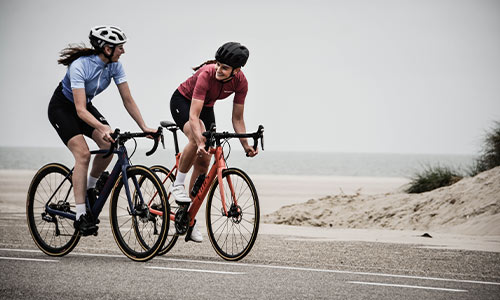Common Bike Problems and Quick Fixes for Smooth Rides
Author
Cycling can be a liberating experience, but unexpected bike problems can quickly dampen the joy of riding. In this informative guide, we will explore some of the most common bike issues and provide quick and effective fixes for each one. From punctures to gear jumps, we've got you covered with practical solutions to keep you rolling smoothly on your two-wheeled adventures.

- Snapped Chain:
While a snapped chain might seem daunting, it is a straightforward fix with the right tools. You'll need quick links and a chain tool. Thread the broken chain back on and place the bike in the smallest chainring and sprocket. With the broken section at the bottom, use the chain tool to push the rivet through the broken link. Connect the chain using the quick link, ensuring a tight fit.
- Punctures:
Punctures are an inevitable part of cycling, but they need not be a major setback. Fixing a puncture is a relatively simple task that can be accomplished in a matter of minutes. Start by opening the brakes and removing the wheel. Using tire levers, carefully take one side of the tire off the rim to access the inner tube. Inspect the tube for the puncture and ensure that no debris is stuck inside the tire. Once the issue is resolved, replace the tube, reattach the tire, and inflate it using a pump or CO2 cartridge. Practising this repair will serve you well, as it's one of the most common bike problems you'll encounter.
- Jumping Gears:
New bikes may experience gear jumps as the cables stretch slightly. If you notice the chain skipping around the cassette or slow gear changes, you can remedy this by tightening the cable. Use the barrel adjuster and turn it a few times anti-clockwise to resolve the issue.
- Rubbing Brake:
A rubbing brake can be frustrating and hinder your ride. If you have hydraulic or disc brakes and can't adjust them on the go, it's best to address this issue later. For traditional brakes, use a multi-tool to loosen them slightly before tightening them back up. A scraping noise or slight lurch while spinning the wheel indicates brake rubbing. Ensure that the brakes are just slightly tight and not causing any wheel buckling.

- Broken Cleats or Pedals:
Prevention is key with this issue, as fixing it on the road can be challenging. Regular maintenance and replacing worn cleats or pedals can save you from a stranded situation. Cleats are more affordable to replace than pedals, and keeping both in good condition can reduce the risk of knee injuries.
- Aches and Pains:
Sometimes, it's not the bike but our body that needs attention. Persistent aches and pains may indicate an improper bike fit. Booking a professional bike fit can ensure that your knees and hips are properly aligned and that you are in the most efficient riding position. Check your saddle for comfort and make necessary adjustments for a more enjoyable and sustainable ride.
Conclusion:
By being prepared to tackle common bike problems, you can enjoy uninterrupted rides and explore the open road with confidence. Remember to carry essential tools and supplies with you, such as tire levers, a multi-tool, and spare tubes, to address minor issues on the go. Additionally, regular bike maintenance and professional fittings will ensure your bike is in top condition, reducing the likelihood of unexpected problems. With these practical solutions in mind, you can ride worry-free, knowing that you have the know-how to handle any hiccups that come your way. Happy cycling!
Author
Categories
- Sport (28)
- Product Reviews (3)
- Team Outdoor Look (7)
- Mike Wild (2)
- Mike Payton (2)
- Suse Hammond-Pears (3)
- Snowboarding (12)
- Latest Offers (105)
- Shop Talk (1)
- Competitions (7)
- Walking (413)
- Lifestyle Fashion (8)
- Travel (86)
- Kit Guides (176)
- Workwear Clothing (6)
- Safety Workwear (4)
- Health/Fitness (289)
- Skiing (91)
- Great Outdoors (1316)
- Cycling (92)
- January 2025
- December 2024
- November 2024
- October 2024
- September 2024
- August 2024
- July 2024
- June 2024
- May 2024
- April 2024
- March 2024
- February 2024
- January 2024
- December 2023
- November 2023
- October 2023
- September 2023
- August 2023
- July 2023
- June 2023
- May 2023
- April 2023
- March 2023
- February 2023
- January 2023
- December 2022
- November 2022
- October 2022
- September 2022
- August 2022
- July 2022
- June 2022
- May 2022
- April 2022
- March 2022
- February 2022
- January 2022
- December 2021
- November 2021
- October 2021
- September 2021
- August 2021
- July 2021
- June 2021
- May 2021
- April 2021
- March 2021
- February 2021
- January 2021
- December 2020
- November 2020
- October 2020
- September 2020
- August 2020
- July 2020
- June 2020
- May 2020
- April 2020
- March 2020
- February 2020
- January 2020
- December 2019
- November 2019
- October 2019
- September 2019
- August 2019
- July 2019
- June 2019
- May 2019
- April 2019
- March 2019
- February 2019
- January 2019
- December 2018
- November 2018
- October 2018
- September 2018
- August 2018
- July 2018
- June 2018
- May 2018
- April 2018
- March 2018
- February 2018
- January 2018
- December 2017
- November 2017
- October 2017
- September 2017
- August 2017
- July 2017
- June 2017
- May 2017
- April 2017
- March 2017
- February 2017
- January 2017
- December 2016
- November 2016
- October 2016
- September 2016
- August 2016
- July 2016
- June 2016
- May 2016
- April 2016
- March 2016
- February 2016
- January 2016
- December 2015
- November 2015
- October 2015
- September 2015
- August 2015
- July 2015
- June 2015
- May 2015
- April 2015
- March 2015
- February 2015
- January 2015
- December 2014
- November 2014
- October 2014
- September 2014
- August 2014
- July 2014
- June 2014
- May 2014
- April 2014
- March 2014
- February 2014
- January 2014
- December 2013
- November 2013
- October 2013
- September 2013
- August 2013
- July 2013
- June 2013
- May 2013
- April 2013
- March 2013
- February 2013
- January 2013
- December 2012
- November 2012
- October 2012
- September 2012
- August 2012
- July 2012
- June 2012
- May 2012
- April 2012
- March 2012
- February 2012
- January 2012
- December 2011
- November 2011
- October 2011
- September 2011
- August 2011
- May 2010
- April 2010
- March 2010
- February 2010
- January 2010
- November 2009
- October 2009
- September 2009


Submit a Comment